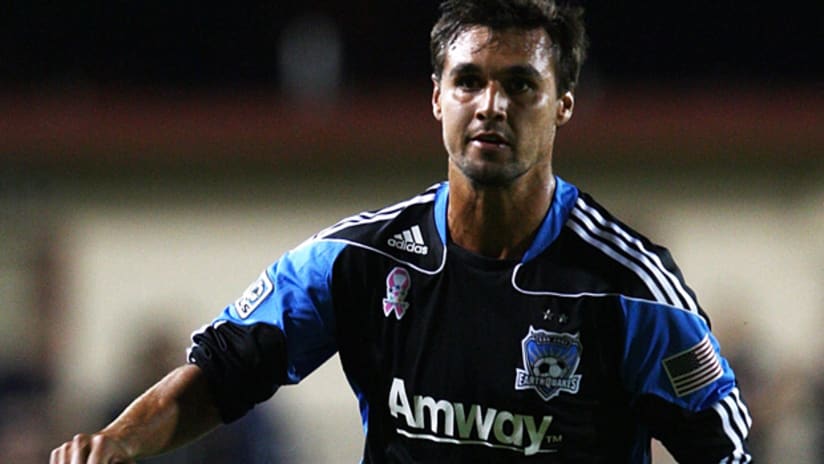The San Jose Earthquakes kicked off their 2012 MLS Reserve League season on Tuesday with a thoroughly entertaining and surprisingly competitive 1-0 victory over the Portland Timbers. A second half 25-yard blast from holding midfielder Jean-Marc Alexandre proved the difference for the Earthquakes, as both sides had numerous chances to score but failed to capitalize on their opportunities. Still, credit goes to both goalkeepers on the day, as well as to some timely defending from both sides, for keeping the game such a tight encounter.
This season marks the second year of the revitalized Reserve League, as the program was suspended by MLS during the 2009 and 2010 campaigns following its introduction in 2005. Somewhat marginalized by those that claim to support the game, the Reserve League serves an important role for teams that want an organized method for evaluating talent. Earthquakes assistant coach Mark Watson, who served as head coach in Tuesday’s 1-0 win over Portland, gave his full sport to a league that has become an important component in the team’s training schedule.
“Absolutely, for us it is vital,” shared Watson. “We’ve seen a couple players come through to our first team now that really got their feet wet in the reserves. You can improve a lot in training, you are training with some good guys, but ultimately it is about a big field and real 11 v. 11 games. So the league is vital for guys to learn and grow as professionals, and also to stay fit and be ready for the squad.”
The poster boy for the benefits of the Reserve League also happens to be the current face of the San Jose Earthquakes franchise — star forward Chris Wondolowski. A Supplemental Draft pick by the Earthquakes prior to the 2005 MLS season, Wondolowski made a name for himself cutting his teeth in that season’s reserve squad, an experience he is quick to credit for keeping him on the path to success.
“It kept me in this league (MLS), being able to show myself and keep me around the coaches. You can only do so much in practice because they are geared to the first team and the eleven guys that are likely to be starting. So, it's really hard for the coaches to see everyone and get everyone involved, whereas the Reserve League games provide an MLS-caliber situation where you can go out and try to do well. That’s what kept me in this league and I am always grateful for that.”
Wondolowski finished his first Reserve League season with eight goals in 12 matches for the Earthquakes. When the franchise was moved to Houston, he continued to impress the coaching staff by scoring 26 goals for the Dynamo reserves over the next three years. That track record of scoring success was a big part of why the Earthquakes traded for the “Reserve League King” in June of 2009, and just over a year later watched as Wondolowski captured the MLS Golden Boot award.
When the Reserve League went on a two year hiatus following the 2008 season, a valuable avenue for players such as Wondolowski to make their cases to MLS coaches went by the wayside. For the influential Earthquakes rookie class of 2009, that included current starters Steven Beitashour and Justin Morrow, the chance to break into the first team was made much harder by the lack of playing competitive games.
“The first year we didn’t have it,” explained Morrow, “but my second year was the return of the Reserve League and I think it helped me out a lot. It’s about getting to play competitive games every week. When the Reserve League wasn't around, maybe you faced a couple of college teams every couple of months, but now that there is a league, there are always competitive games.”
Morrow is another case study in what is right about the Reserve League. A seldom used rookie, the defender saw his stock rise during his sophomore MLS season, in small part due to the experience he gained playing with the reserves. Earthquakes head coach Frank Yallop agreed that without that proving ground in 2011, the pace of development that now sees Morrow starting for San Jose at center back would have potentially been hindered.
“Yes, for sure,” said Yallop when asked to rate the Reserve League. “It gives us a chance to look at a Justin Morrow, for example, in a position and in a game that is against pros as well. It is important, since it is \not just a college team, it is a game against professionals that are trying to do the same thing as us. Reserves are all trying to get a chance to play with their first teams.”
Whether asked to hone their skills at their natural positions, or whether the assignment is to add to their versatility, the Reserve League provides players a venue to keep the attention of the coaching staff. Morrow, in a similar expression of appreciation as shared by his teammate Wondolowski, is grateful to now be considered worthy and capable and lining up in Yallop’s MLS starting XI, and he encourages others on the team to take advantage of the opportunities afforded by the Reserve League.
“The more versatile you can be the better,” shared Morrow. “I don’t think they would have given me the chance to just jump into a first team game at center back, but since the coaches saw me play in the Reserve League at center back they knew I could do it. It just gives players chances that way.”
With one game down and nine more left on the 2012 season schedule, keep a close eye on the Reserve League for perhaps the next star of the San Jose Earthquakes.
Robert Jonas is a writer for CenterLineSoccer.com and SJEarthquakes.com. Send him feedback on Twitter: @RobertJonas


